Fumaric Acid and Slightly Acidic Electrolyzed Water Inactivate Gram Positive and Gram Negative Foodborne Pathogens
Abstract
:1. Introduction
2. Materials and Methods
2.1. Bacterial Strain and Preparation of Inoculums
2.2. Preparation of Slightly Acidic Electrolyzed Water and Fumaric Acid
2.3. Treatment of Foodborne Pathogens with Sanitizers
2.4. Statistical Analysis
3. Results
| Treatment Solutions | Concentration | pH | ORP (mV) |
|---|---|---|---|
| FA | 0.125 1 | 2.67 ± 095 | 592–596 ± 1.03 |
| 0.25 | 2.42 ± 1.22 | 575–786 ± 1.14 | |
| 0.5 | 2.34 ± 2.21 | 568–573 ± 1.32 | |
| SAEW | 5 2 | 6.40 ± 1.28 | 826–859 ± 1.31 |
| 10 | 5.71 ± 1.05 | 854–878 ± 2.05 | |
| 20 | 6.06 ± 1.19 | 848–852 ± 1.42 | |
| 30 | 6.29 ± 2.01 | 820–934 ± 1.29 |
3.1. Effect of Temperature on the Sanitizing Effect of Fumaric Acid and SAEW
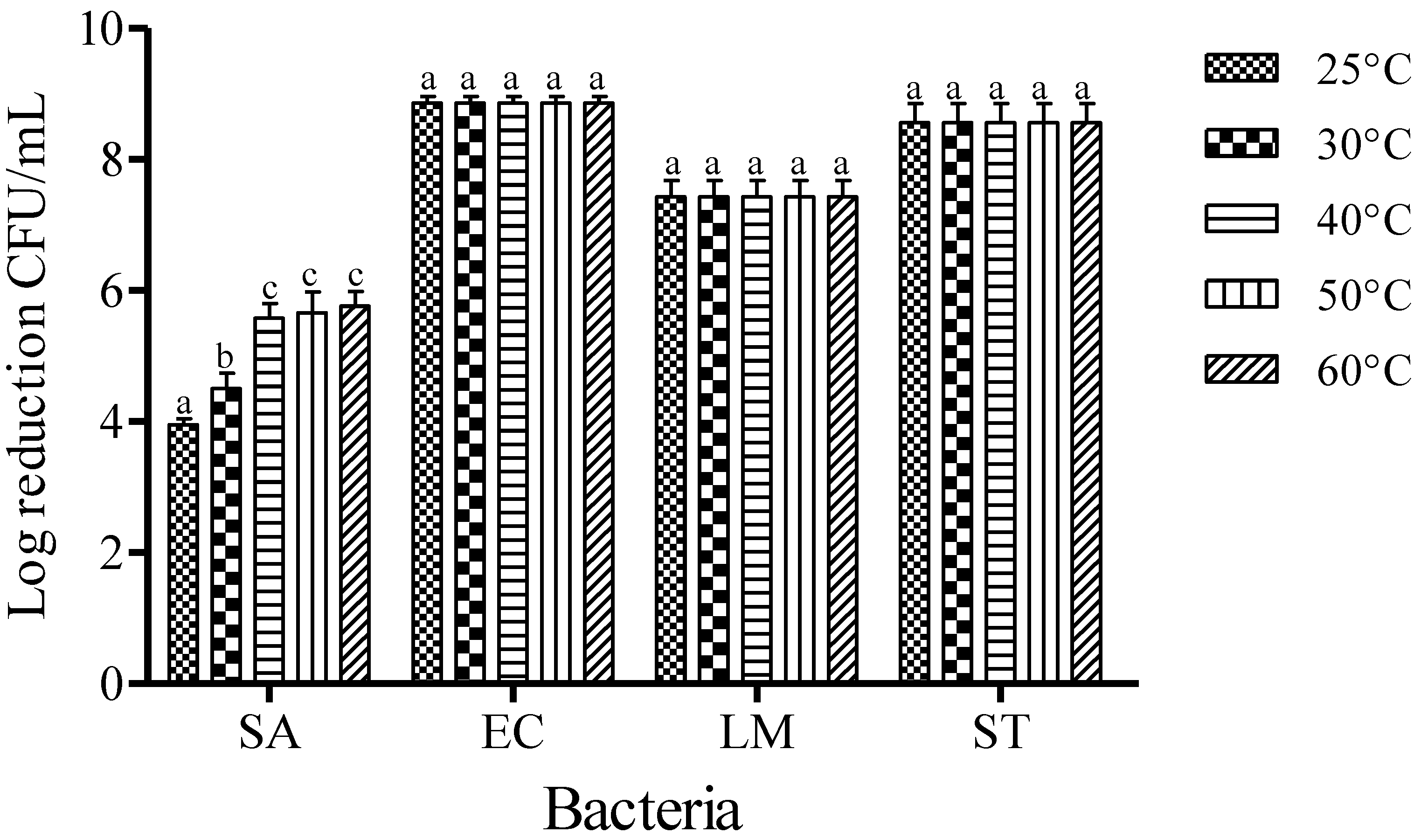
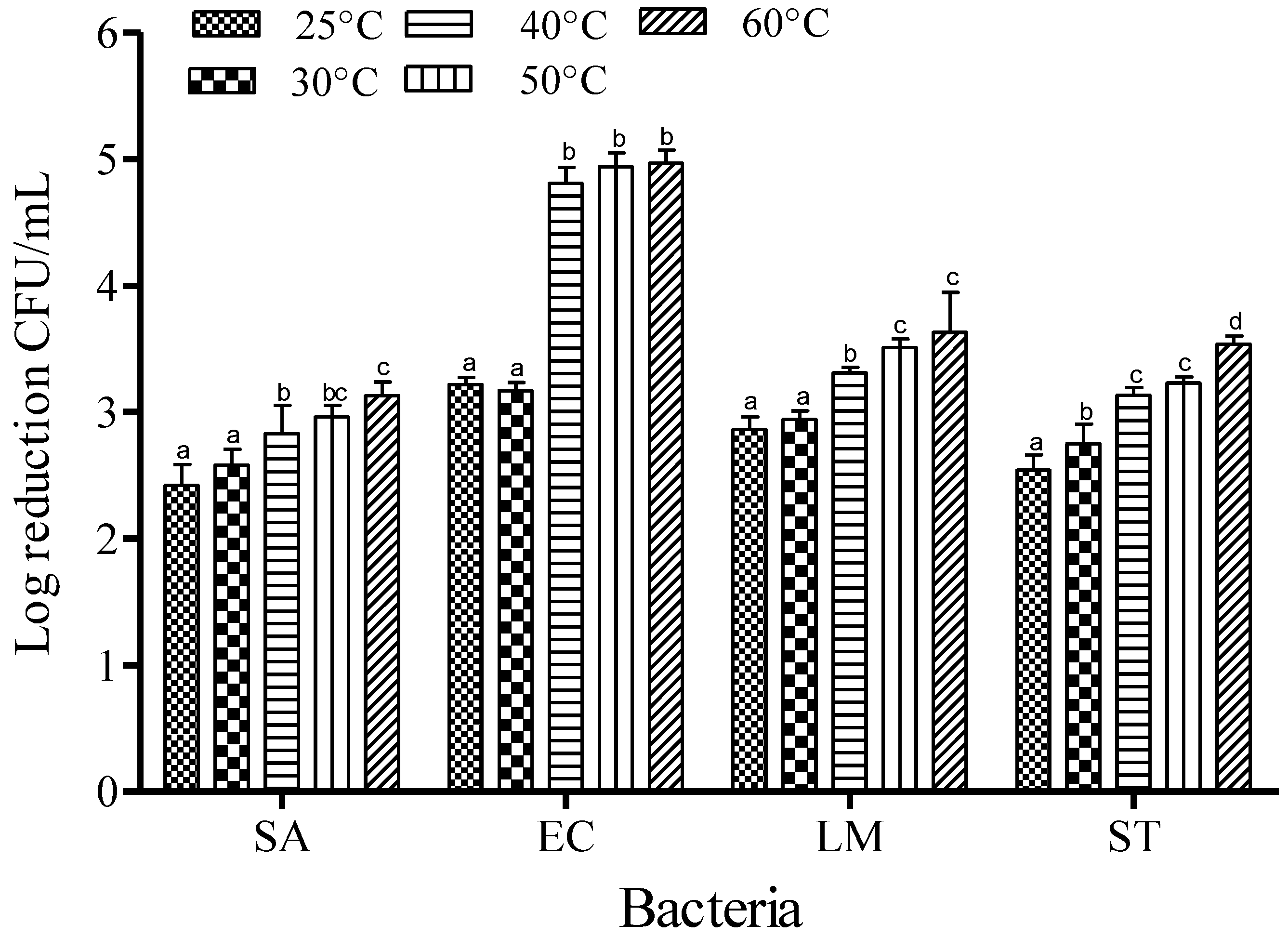
3.2. Effect of Concentration on Sanitizing Effect of Fumaric Acid and SAEW
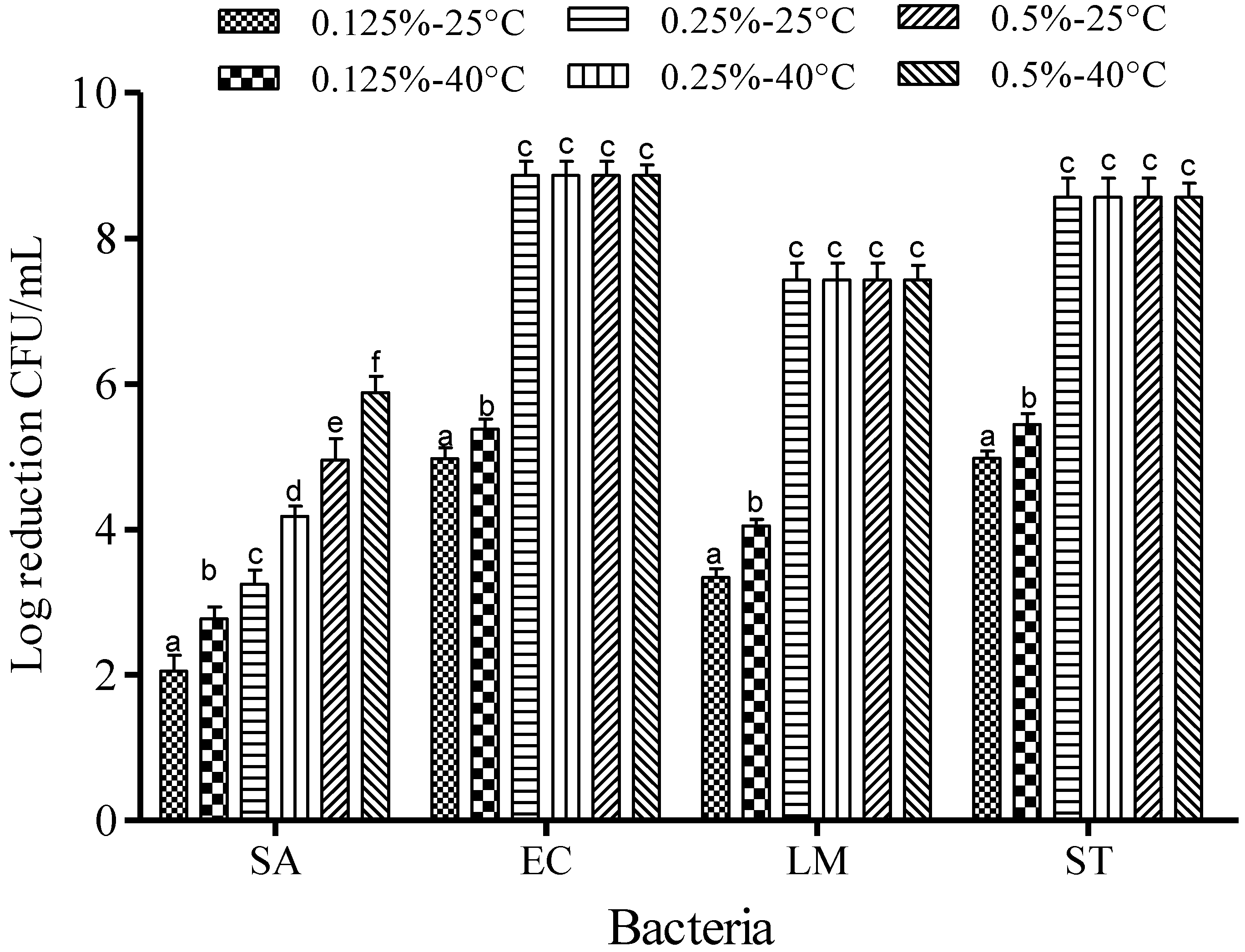
3.3. Effect of Dipping Time on Sanitizing Effect of SAEW
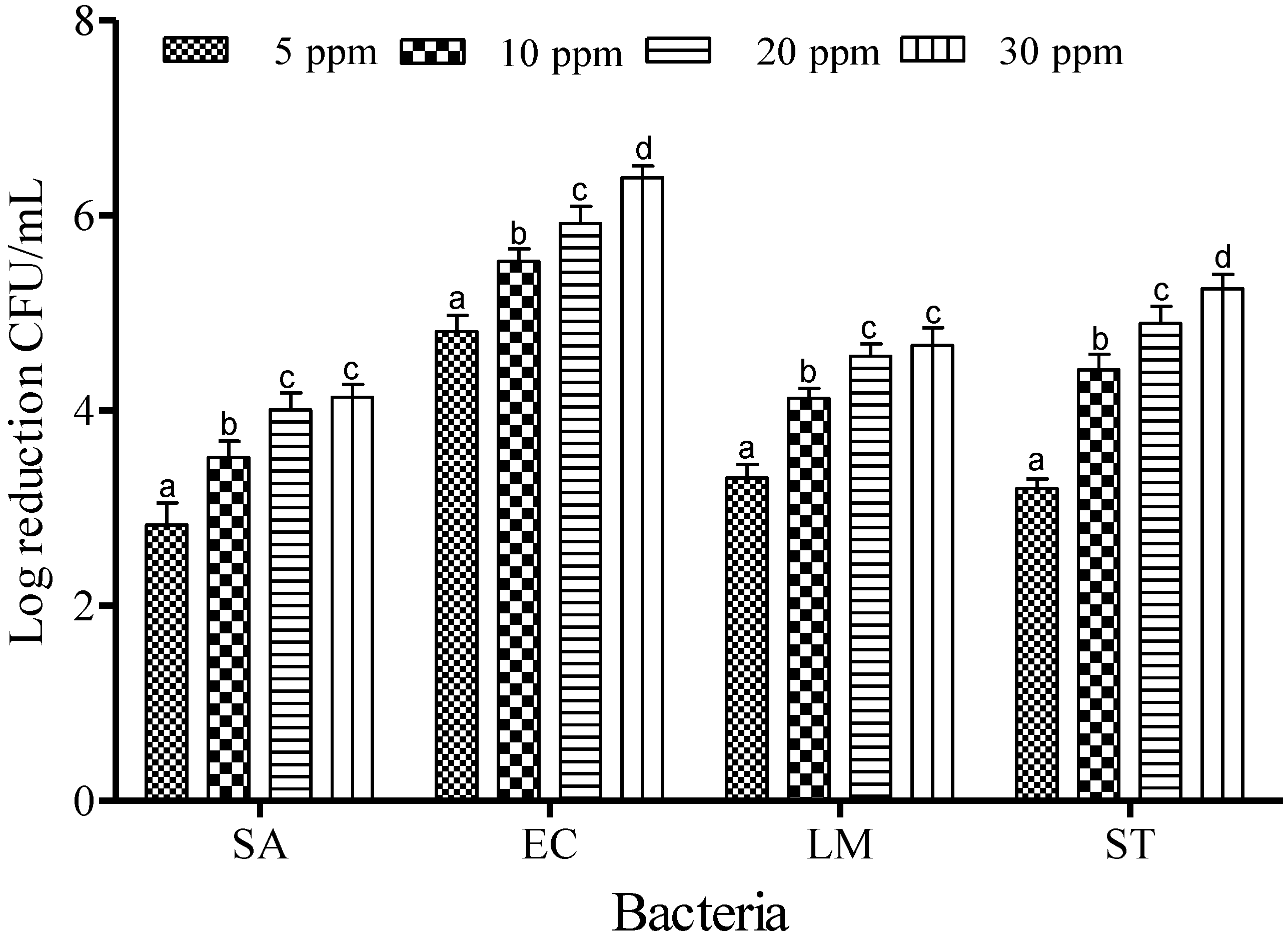
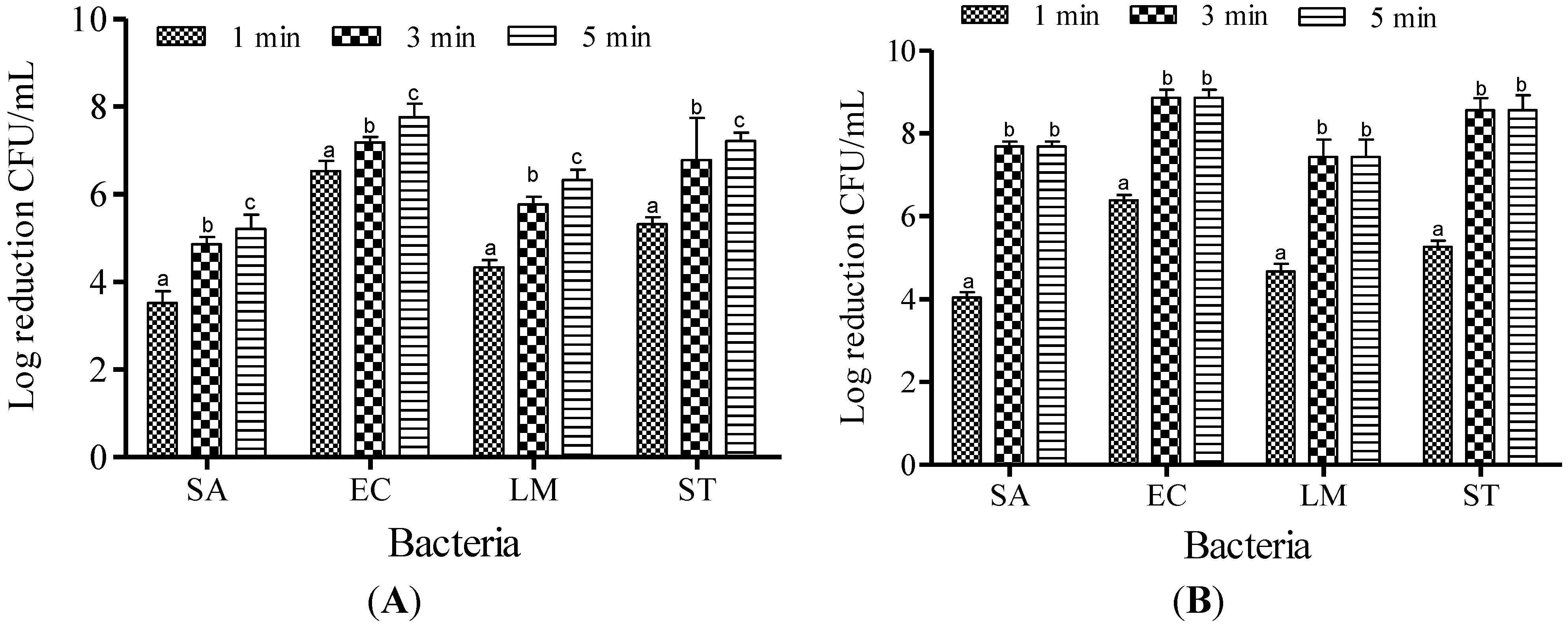
4. Discussion
5. Conclusions
Acknowledgments
Author Contributions
Conflicts of Interest
References
- Issa-Zachari, A.; Kamitani, Y.; Morita, K.; Iwasaki, K. Sanitization potency of slightly acidic electrolyzed water against pure cultures of Escherichia coli and Staphylococcus aureus, in comparison with that of other food sanitizers. Food Control 2010, 21, 740–745. [Google Scholar] [CrossRef]
- Suzuki, T.; Jun, I.; Masumi, W.; Mari, O.; Yuri, S.; Yuko, Y. Inactivation of staphylococcal enterotoxin—A with an electrolyzed anodic solution. J. Agric. Food Chem. 2001, 50, 230–234. [Google Scholar] [CrossRef]
- Smigic, N.; Rajkovic, A.; Antal, E.; Medic, H.; Lipnicka, B.; Uyttendaele, M.; Devlieghere, F. Treatment of Escherichia coli O157:H7 with lactic acid, neutralized electrolyzed oxidizing water and chlorine dioxide followed by growth under sub-optimal conditions of temperature, pH and modified atmosphere. Food Microbiol. 2009, 26, 629–637. [Google Scholar] [CrossRef] [PubMed]
- Jadeja, R.; Hung, Y.C. Efficacy of near neutral and alkaline pH electrolyzed oxidizing waters to control Escherichia coli O157:H7 and Salmonella Typhimurium DT 104 from beef hides. Food Control 2014, 41, 17–20. [Google Scholar] [CrossRef]
- Kim, C.; Hung, Y.C.; Russell, S.M. Efficacy of electrolyzed water in the prevention and removal of fecal material attachment and its microbicidal effectiveness during simulated industrial poultry processing. Poult. Sci. 2005, 84, 1778–1784. [Google Scholar] [CrossRef] [PubMed]
- Forghani, F.; Oh, D.H. Hurdle enhancement of slightly acidic electrolyzed water antimicrobial efficacy on Chinese cabbage, lettuce, sesame leaf and spinach using ultrasonication and water wash. Food Microbiol. 2013, 36, 45–50. [Google Scholar] [CrossRef]
- Fabrizio, K.A.; Sharma, R.R.; Demirci, A.; Cutter, C.N. Comparison of electrolyzed oxidizing water with various antimicrobial interventions to reduce Salmonella species on poultry. Poult. Sci. 2002, 81, 1598–1605. [Google Scholar] [CrossRef] [PubMed]
- Ozer, N.P.; Demirci, A. Electrolyzed oxidizing water treatment for decontamination of raw salmon inoculated with Escherichia coli O157:H7 and Listeria monocytogenes Scott A and response surface modeling. J. Food Eng. 2006, 72, 234–241. [Google Scholar] [CrossRef]
- Deza, M.A.; Araujo, M.; Garrido, M.J. Inactivation of Escherichia coli, Listeria monocytogenes, Pseudomonas aeruginosa and Staphylococcus aureus on stainless steel and glass surfaces by neutral electrolysed water. Lett. Appl. Microbiol. 2005, 40, 341–346. [Google Scholar] [CrossRef] [PubMed]
- Anang, D.M.; Rusul, G.; Bakar, J.; Ling, F.H. Effects of lactic acid and lauricidin on the survival of Listeria monocytogenes, Salmonella enteritidis and Escherichia coli O157:H7 in chicken breast stored at 4 °C. Food Control 2007, 18, 961–969. [Google Scholar] [CrossRef]
- Sakhare, P.Z.; Sachindra, N.M.; Yashoda, K.P.; Rao, N.D. Efficacy of intermittent decontamination treatments during processing in reducing the microbial load on broiler chicken carcass. Food Control 1999, 10, 189–194. [Google Scholar] [CrossRef]
- Uljas, H.E.; Ingham, S.C. Survival of Escherichia coli O157:H7 in synthetic gastric fluid after cold and acid habituation in apple juice or trypticase soy broth acidified with hydrochloric acid or organic acids. J. Food. Prot. 1998, 61, 939–947. [Google Scholar] [PubMed]
- Podolak, R.K.; Zayas, J.F.; Kasner, C.L.; Fung, D.Y.C. Inhibition of Listeria monocytogenes and E. coli. O157:H7 on Beef by Applications of Organic Acids. J. Food Prot. 1996, 59, 370–373. [Google Scholar]
- Kondo, N.; Murata, M.; Isshiki, K. Efficiency of sodium hypochlorite, fumaric acid, and mild heat in killing native microflora and Escherichia coli O157:H7, Salmonella Typhimurium DT104, and Staphylococcus aureus attached to fresh-cut lettuce. J. Food Prot. 2006, 69, 323–329. [Google Scholar] [PubMed]
- Chikthimmah, N.; Laborde, L.F.; Beelman, R.B. Critical factors affecting the destruction of Escherichia coli O157:H7 in apple cider treated with fumaric acid and sodium benzoate. J. Food Sci. 2003, 68, 1438–1442. [Google Scholar] [CrossRef]
- Koutsoumanis, K.P.; Ashton, L.V.; Geornaras, I.; Belk, K.E.; Scanga, J.A.; Kendall, P.A.; Smith, G.C.; Sofos, J.N. Effect of Single or Sequential Hot Water and Lactic Acid Decontamination Treatments on the Survival and Growth of Listeria monocytogenes and Spoilage Microflora during Aerobic Storage of Fresh Beef at 4, 10, and 25.8 °C. J. Food Prot. 2004, 67, 2703–2711. [Google Scholar] [PubMed]
- Issa-Zacharia, A.; Kamitani, Y.; Tiisekwa, A.; Morita, K.; Iwasaki, K. In vitro inactivation of Escherichia coli, Staphylococcus aureus and Salmonella spp. using slightly acidic electrolyzed water. J. Biosci. Bioeng. 2010, 110, 308–313. [Google Scholar] [CrossRef] [PubMed]
- Suutari, M.; Laakso, S. Microbial fatty acids and thermal adaptation. Crit. Rev. Microbiol. 1994, 20, 285–328. [Google Scholar] [CrossRef] [PubMed]
- Nan, S.; Li, Y.G.; Li, B.M.; Wang, C.Y.; Cui, X.D.; Cao, W. Effect of Slightly Acidic Electrolyzed Water for Inactivating Escherichia coli O157:H7 and Staphylococcus aureus Analyzed by Transmission Electron Microscopy. J. Food Prot. 2010, 73, 2211–2216. [Google Scholar] [PubMed]
- Rode, T.M.; Møretrø, T.; Langsrud, S.; Langsrud, O.; Vogt, G.; Holck, A. Responses of Staphylococcus aureus exposed to HCl and organic acid stress. Can. J. Microbiol. 2010, 56, 777–792. [Google Scholar] [CrossRef] [PubMed]
- Pohlman, F.W.; Stivarius, M.R.; McElyea, K.S.; Johnson, Z.B.; Johnso, M.G. The effects of ozone, chlorine dioxide, cetylpyridinium chloride and trisodium phosphate as multiple antimicrobial interventions on microbiological, instrumental color, and sensory color and odor characteristics of ground beef. Meat Sci. 2002, 61, 307–313. [Google Scholar] [CrossRef] [PubMed]
- Burnett, S.L.; Beuchat, L.R. Human pathogens associated with raw produced and unpasteurized juices, and difficulties in decontamination. J. Ind. Microbiol. Biotechnol. 2000, 25, 281–287. [Google Scholar] [CrossRef] [PubMed]
- Cotter, P.D.; Hill, C. Surviving the Acid Test: Responses of Gram Positive Bacteria to Low pH. Microbiol. Mol. Biol. Rev. 2003, 67, 429–453. [Google Scholar] [CrossRef] [PubMed]
- Foster, J.W.; Hall, H.K. Adaptive acidification tolerance response of Salmonella Typhimurium. J. Bacteriol. 1990, 172, 771–778. [Google Scholar] [PubMed]
- O’Driscoll, B.; Gahan, C.G.; Hill, C. Adaption acid tolerance in Listeria monocytogenes: Isolation of an acid-tolerance mutant which demonstrates increased virulence. Appl. Environ. Microbiol. 1996, 62, 1693–1698. [Google Scholar] [PubMed]
- Eklund, T. The antimicrobial effect of dissociated and undissociated sorbic acid at different pH levels. J. Appl. Bacteriol. 1983, 54, 383–389. [Google Scholar] [CrossRef] [PubMed]
© 2015 by the authors; licensee MDPI, Basel, Switzerland. This article is an open access article distributed under the terms and conditions of the Creative Commons Attribution license (http://creativecommons.org/licenses/by/4.0/).
Share and Cite
Tango, C.N.; Mansur, A.R.; Oh, D.-H. Fumaric Acid and Slightly Acidic Electrolyzed Water Inactivate Gram Positive and Gram Negative Foodborne Pathogens. Microorganisms 2015, 3, 34-46. https://doi.org/10.3390/microorganisms3010034
Tango CN, Mansur AR, Oh D-H. Fumaric Acid and Slightly Acidic Electrolyzed Water Inactivate Gram Positive and Gram Negative Foodborne Pathogens. Microorganisms. 2015; 3(1):34-46. https://doi.org/10.3390/microorganisms3010034
Chicago/Turabian StyleTango, Charles Nkufi, Ahmad Rois Mansur, and Deog-Hwan Oh. 2015. "Fumaric Acid and Slightly Acidic Electrolyzed Water Inactivate Gram Positive and Gram Negative Foodborne Pathogens" Microorganisms 3, no. 1: 34-46. https://doi.org/10.3390/microorganisms3010034
APA StyleTango, C. N., Mansur, A. R., & Oh, D.-H. (2015). Fumaric Acid and Slightly Acidic Electrolyzed Water Inactivate Gram Positive and Gram Negative Foodborne Pathogens. Microorganisms, 3(1), 34-46. https://doi.org/10.3390/microorganisms3010034







